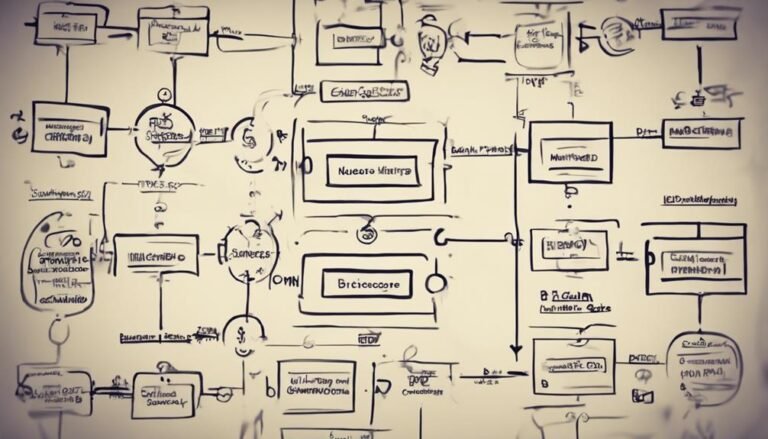Enhancing SME Operational Efficiency
Enhancing operational efficiency is a critical aspect for SMEs looking to optimize their processes and drive growth. By streamlining operations and minimizing wastage, businesses can improve their bottom line and stay competitive in today's fast-paced market.
From identifying key bottlenecks to implementing automation solutions and leveraging data analytics tools, there are various strategies that can be employed to enhance efficiency. However, one crucial element often overlooked is the role of employee training and development in this equation.
How can investing in your workforce lead to further improvements in operational efficiency? Let's explore this further.
Key Takeaways
- Thorough bottleneck analysis improves overall operational efficiency.
- Process optimization and automation reduce costs and boost productivity.
- Leveraging digital tools enhances team communication and collaboration.
- Implementing continuous improvement techniques drives sustainable growth for SMEs.
Importance of Operational Efficiency
Operational efficiency stands as the cornerstone of small and medium enterprises (SMEs), driving sustainable growth and competitive advantage in today's dynamic business landscape. To achieve operational excellence, SMEs must focus on performance metrics, process optimization, workflow analysis, and resource allocation.
Performance metrics play a crucial role in measuring the effectiveness of operations within SMEs. By defining and tracking key performance indicators (KPIs), businesses can identify areas for improvement and gauge the success of their operational strategies.
Process optimization is another vital aspect that SMEs need to prioritize. Through streamlining workflows and eliminating bottlenecks, organizations can enhance productivity and reduce operational costs.
Workflow analysis allows SMEs to identify inefficiencies and redundancies in their processes, enabling them to make informed decisions on how to improve overall efficiency. Moreover, strategic resource allocation is essential for maximizing productivity and minimizing waste. By allocating resources effectively, SMEs can ensure that the right people and tools are in place to support their operations efficiently.
In essence, operational efficiency is not merely a goal but a strategic imperative for SMEs looking to thrive in today's competitive business environment.
Identifying Key Bottlenecks
Identifying key bottlenecks within SME operations is crucial for streamlining processes and enhancing overall efficiency.
By conducting thorough bottleneck analysis, businesses can pinpoint areas that impede workflow and productivity.
Implementing targeted efficiency solutions tailored to address these bottlenecks can significantly improve operational performance and drive business growth.
Bottleneck Analysis
To optimize operational performance and streamline processes within small and medium-sized enterprises (SMEs), it is essential to conduct thorough bottleneck analysis to identify key areas hindering efficiency. This analysis involves delving into the root causes of inefficiencies and focusing on process optimization. By identifying bottlenecks, businesses can strategically allocate resources to areas that need improvement, ultimately enhancing overall productivity and effectiveness.
To conduct a successful bottleneck analysis, SMEs should consider the following:
- Utilize process mapping: Visualizing workflows can help pinpoint potential bottlenecks.
- Collect data: Quantitative analysis provides insights into where delays occur most frequently.
- Engage employees: Involving staff in the analysis can offer valuable frontline perspectives on operational challenges.
Efficiency Solutions
Enhancing SME operational efficiency through targeted solutions for bottleneck identification is a crucial step towards optimizing overall performance. Process optimization plays a key role in streamlining operations, reducing redundancies, and enhancing productivity.
By identifying and addressing key bottlenecks, businesses can significantly improve efficiency and cost-effectiveness. Implementing workflow automation can further boost operational efficiency by reducing manual errors and enhancing task completion speed.
Resource optimization is essential in maximizing output while minimizing input, ensuring that SMEs operate at peak efficiency levels. By focusing on these efficiency solutions, SMEs can overcome challenges, enhance competitiveness, and drive sustainable growth in today's dynamic business environment.
Implementing Automation Solutions
To enhance operational efficiency, the integration of automation solutions can significantly impact small and medium enterprises. By streamlining manual processes and embracing automation, businesses can reduce human error and increase productivity.
This shift towards automation not only saves time but also allows SMEs to reallocate resources to focus on growth and innovation.
Streamlining Manual Processes
Implementing automation solutions in SMEs is crucial for streamlining manual processes and enhancing operational efficiency. By incorporating process optimization and workflow automation, businesses can achieve greater efficiency and accuracy in their operations.
Manual labor reduction is another key benefit of automation, allowing employees to focus on more strategic tasks that require human intervention. Efficiency maximization is also a significant advantage, as automation can complete tasks faster and with fewer errors than manual processes.
Increasing Productivity Through Automation
To capitalize on the potential for increased operational efficiency and productivity, small and medium-sized enterprises can strategically leverage automation solutions to streamline processes and drive growth. Implementing technology integration and process automation can significantly enhance workforce optimization and overall performance metrics. By automating repetitive tasks, businesses can reallocate human resources to more strategic activities, ultimately boosting productivity. Automation also reduces the likelihood of errors, leading to improved accuracy and efficiency in operations. Additionally, the data generated through automation can provide valuable insights for decision-making and process optimization. Small businesses that embrace automation not only save time and resources but also position themselves for long-term success in an increasingly competitive market.
| Technology Integration | Workforce Optimization | Process Automation |
|---|---|---|
| Streamline operations by integrating software systems | Optimize workforce allocation based on automated insights | Automate repetitive tasks for increased efficiency |
Leveraging Data Analytics Tools
How can small and medium-sized enterprises harness the power of data analytics tools to enhance their operational efficiency?
Data analytics tools offer SMEs valuable insights that can drive decision-making processes and streamline operations. By leveraging predictive analytics, businesses can anticipate trends and make proactive decisions, ultimately improving their overall efficiency. Additionally, data visualization tools can help in tracking performance metrics in real-time, allowing for quick adjustments and optimizations to enhance productivity.
Key Strategies for Leveraging Data Analytics Tools:
- Implement Predictive Analytics: Utilize predictive analytics to forecast trends, identify potential risks, and make informed decisions.
- Utilize Data Visualization: Employ data visualization tools to represent complex data in a visual format, making it easier to interpret and act upon.
- Track Performance Metrics: Monitor key performance indicators in real-time to identify bottlenecks, inefficiencies, and areas for improvement promptly.
Enhancing Communication Channels
Enhancing communication channels is essential for small and medium-sized enterprises seeking to optimize operational processes and foster collaboration among team members. In today's dynamic business environment, remote collaboration and virtual meetings have become crucial components of effective communication strategies. By leveraging digital platforms and tools, SMEs can facilitate seamless team communication, regardless of geographical barriers.
Virtual meetings enable real-time interactions, ensuring that teams stay connected and aligned on tasks and objectives. Platforms such as Zoom, Microsoft Teams, or Slack provide avenues for video conferencing, instant messaging, and file sharing, enhancing productivity and reducing communication gaps. Effective team communication fosters transparency, boosts morale, and promotes a sense of unity among employees.
Moreover, digital platforms offer features like project management tools, task assignment functionalities, and collaborative workspaces, streamlining processes and enhancing efficiency. By embracing these technologies, SMEs can overcome communication challenges, improve decision-making, and drive organizational success in today's fast-paced business landscape.
Employee Training and Development
Effective employee training and development plays a pivotal role in enhancing operational efficiency within small and medium-sized enterprises, fostering a culture of continuous improvement and skill enhancement among team members. Investing in skills development and performance improvement can yield significant benefits for SMEs.
Here are three key aspects to consider:
- Tailored Training Programs: Designing customized training programs based on the specific needs and roles of employees can enhance their skills more effectively.
- Continuous Learning Opportunities: Providing ongoing learning opportunities, such as workshops, seminars, and online courses, can keep employees updated with the latest industry trends and technologies.
- Feedback Mechanisms: Establishing feedback mechanisms to evaluate the effectiveness of training programs and identify areas for improvement can ensure that employee development initiatives align with the organization's goals.
Continuous Process Improvement
Implementing a systematic approach to continuous process improvement is essential for optimizing operational efficiency and fostering sustainable growth within small and medium-sized enterprises. By embracing lean management techniques and operational excellence principles, businesses can streamline their operations, eliminate waste, and enhance overall productivity. Kaizen methodology, a Japanese concept emphasizing continuous improvement, plays a crucial role in this process. It involves making small, incremental changes to processes, systems, and behaviors to achieve performance optimization gradually.
Small and medium-sized enterprises can benefit significantly from adopting Kaizen practices as they are cost-effective and focus on engaging employees at all levels. Encouraging a culture of continuous improvement empowers employees to identify inefficiencies, suggest improvements, and drive positive change within the organization. This iterative approach not only enhances efficiency but also boosts employee morale and satisfaction, leading to a more productive and harmonious work environment. Overall, integrating Kaizen methodology into the company's operations can result in sustainable improvements and long-term success for SMEs seeking operational excellence.
Conclusion
Enhancing SME operational efficiency is crucial for sustained success in today's competitive business landscape.
By identifying key bottlenecks, implementing automation solutions, leveraging data analytics tools, enhancing communication channels, investing in employee training and development, and continuously improving processes, SMEs can streamline their operations and achieve higher levels of productivity.
Embracing these strategies will not only optimize resource utilization but also drive growth and profitability, positioning SMEs for long-term success in the market.







